Author: Steve Crum
The movie song ends for three composers
During July-August 2004, three superb motion picture composers died. That prompted my piece about the trio in my Kansas City Kansan column, Crum on Film, first published on August 25 that summer. It is reposted here.
By Steve Crum
Imagine movie legends Clark Gable, Katharine Hepburn, and Humphrey Bogart dying with the same month. (They actually passed away years apart.) Essentially that sad coincidence has occurred in the world of movie music. Three superstar film composers have died within the last few weeks: Elmer Bernstein (Aug. 18), Jerry Goldsmith (July 21), and David Raksin (Aug. 9).
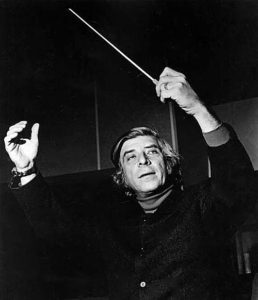 ELMER BERNSTEIN
ELMER BERNSTEIN
To the general public Elmer Bernstein will forever be known through his theme for 1960’s The Magnificent Seven, which during the years preceding 1971 was also the Marlboro Cigarettes theme in commercials.

1971 was the year TV banned cigarette ads. Bernstein (no relation to Leonard) began his career as a protégé of American classical composer Aaron Copland. Bernstein’s scores for radio and TV shows led to his first significant movie score, The Man with the Golden Arm (1955). It was jazz, and uncharacteristic. Then again, Bernstein’s scores were always varied in style, always superb. His only Oscar win was for Thoroughly Modern Millie (1967), another sound entirely. Then there was 1963’s The Great Escape soundtrack. Think Steve McQueen on that motorcycle.
The brilliant Elmer Bernstein was the Mr. Variety of film music. Consider (among his 253 film scores): The Ten Commandments, National Lampoon’s Animal House, Far From Heaven, My Left Foot, Airplane!, The Shootist, Baby the Rain Must Fall, The Hallelujah Trail, True Grit, and Sweet Smell of Success.
My favorite among them all: To Kill a Mockingbird from 1962.
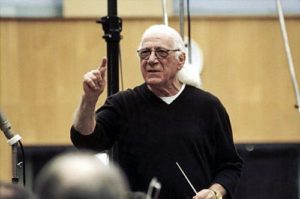 JERRY GOLDSMITH
JERRY GOLDSMITH
Goldsmith also began as a classical music student, and soon segued into CBS radio. There he wrote scores and incidental music to hundreds of radio and TV shows 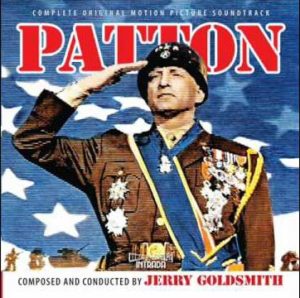 beginning in the early 1950s. His music for The Twilight Zone led to Boris Karloff’s macabre Thriller series. Twentieth Century Fox’s composer-in-residence, Alfred Newman, signed Goldsmith soon after.
beginning in the early 1950s. His music for The Twilight Zone led to Boris Karloff’s macabre Thriller series. Twentieth Century Fox’s composer-in-residence, Alfred Newman, signed Goldsmith soon after.
Three hundred movie soundtracks later, Jerry Goldsmith’s unforgettable scores are more listenable than ever. Among the best: The Blue Max, The Sand Pebbles, A Patch of Blue, Planet of the Apes, Patton, Star Trek: The Motion Picture, The Omen (his only Oscar winner), Hoosiers, Our Man Flint, Lilies of the Field, Rudy, Poltergeist, and the TV theme from The Man from U.N.C.L.E.
My favorite Jerry Goldsmith score: The Boys from Brazil.
DAVID RAKSIN
 With 170 TV and movie scores, Raksin is lesser known than Bernstein or Goldsmith. Yet with one movie score, he will forever ben remembered: Laura (1944). The Otto Preminger directed movie is about a detective (Dana Andrews) falling love with a missing woman (Gene Tierney) shown in a painting. Raksin had to create and sustain a haunting mood. Without the music, which dominates the story, Laura would not be the classic film it is.
With 170 TV and movie scores, Raksin is lesser known than Bernstein or Goldsmith. Yet with one movie score, he will forever ben remembered: Laura (1944). The Otto Preminger directed movie is about a detective (Dana Andrews) falling love with a missing woman (Gene Tierney) shown in a painting. Raksin had to create and sustain a haunting mood. Without the music, which dominates the story, Laura would not be the classic film it is.
The theme was so popular that lyrics (by Johnny Mercer) were added after the film’s release: Laura is the face in the misty lights/Footsteps that hear down the hall….
On an April Saturday in 1989, David Raksin was my teacher for five hours during a film class I was taking at the Doubletree in Overland Park, Kansas. He flew in that morning from the West Coast 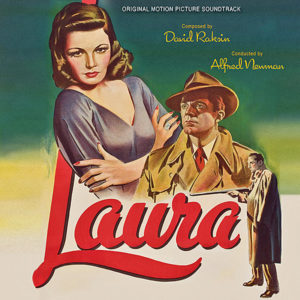 where he was teaching film music course at USC. He was a bit gruff, but very learned.
where he was teaching film music course at USC. He was a bit gruff, but very learned.
The grey-haired, robust Raksin spoke of his early days with George Gershwin. He recalled his collaboration the legendary Charlie Chaplin in creating the score for Modern Times and its bittersweet theme song, Smile. (Smile though your heart is aching/Smile even though it’s breaking.) “I’m not so elaborate in theories,” he said. “I just sit down and write a few notes.”
To illustrate that film is “an art of components,” Raksin first ran a scene from Laura without any music. Then he replayed it with his score. Of course, the dramatic effect of the latter was tremendous.
“Music has to say something,” Raksin said, “to assert itself.” In addition to Laura, Raksin’s melodies asserted themselves in films from 1936, including: The Adventures of Sherlock Holmes, Suez, Smoky, The Secret Life of Walter Mitty, Forever Amber, Daisy Kenyon, The Bad and the Beautiful, and the theme to TV’s Ben Casey.
“To be a successful film composer,” Raksin told me during a break, “takes guts, a gift, and the ability to educate oneself.”
What a defining remark for Raksin, Goldsmith, and Bernstein.
His name may not ring a bell, but his face is known
Not long after actor Richard Jaeckel died at 70 on June 14, 1997, I wrote this tribute piece published in my Crum on Film column in The Kansas City Kansan on June 27.
By Steve Crum
 There is a scene in 1971’s otherwise forgettable Sometimes a Great Notion that stays with me. Give some credit to director and star Paul Newman, but it is Richard Jaeckel’s scene. In it, Jaeckel, as part of a family of Oregon loggers and Newman’s brother, has accidentally pinned himself between some floating logs. He is just off shore and underwater to his chest. As Newman desperately struggles to free his brother, Jaeckel is slowly pulled under as the logs shift. Jaeckel knows he is going to die, and expresses his love and caring to his family (including Henry Fonda) and particularly Newman. Even going inches below the surface to breathe oxygen into his brother’s mouth is fruitless. It is a stunning scene, showcasing Jaeckel’s powerful acting.
There is a scene in 1971’s otherwise forgettable Sometimes a Great Notion that stays with me. Give some credit to director and star Paul Newman, but it is Richard Jaeckel’s scene. In it, Jaeckel, as part of a family of Oregon loggers and Newman’s brother, has accidentally pinned himself between some floating logs. He is just off shore and underwater to his chest. As Newman desperately struggles to free his brother, Jaeckel is slowly pulled under as the logs shift. Jaeckel knows he is going to die, and expresses his love and caring to his family (including Henry Fonda) and particularly Newman. Even going inches below the surface to breathe oxygen into his brother’s mouth is fruitless. It is a stunning scene, showcasing Jaeckel’s powerful acting.
Richard Jaeckel was nominated for Best Supporting Actor for his fantastic performance, his only nomination in a 50 year movie career. He lost to Ben Johnson in The Last Picture Show. (Incidentally, if you cannot find the video, look for it under its released-to-TV title: Never Give an Inch.) Jaeckel, who died on cancer at 70 on June 14, was always the Dick Clark of motion pictures in that he looked much younger than his age. Short, stocky and blonde, he played teenagers when he was in his 20s. That includes the first movie I recall seeing him in, 1952’s Come Back, Little Sheba.
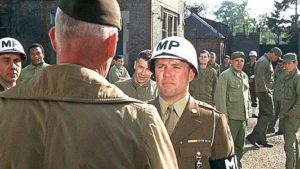 His lasting claim to fame, however, is his support in all four Dirty Dozen movies. That includes the hit 1967 Lee Marvin film and three TV sequels. Remember Jaeckel as Marvin’s right hand MP sergeant? Seemingly monthly cable showings of the classic action film will cement Jaeckel’s movie persona indefinitely.
His lasting claim to fame, however, is his support in all four Dirty Dozen movies. That includes the hit 1967 Lee Marvin film and three TV sequels. Remember Jaeckel as Marvin’s right hand MP sergeant? Seemingly monthly cable showings of the classic action film will cement Jaeckel’s movie persona indefinitely.
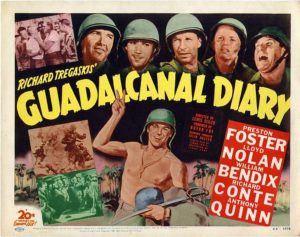 It is not so surprising that the handsomely rugged and buff actor was typecast in films ore so as a military fighting man. That is traced to his very beginning in movies as a teenaged marine in the superior 1943 WWII actioner, Guadalcanal Diary. He played a marine again, this time opposite John Wayne, in Sands of Iwo Jima (1949). Against type, he was featured with Elvis Presley in the western Flaming Star (1960). There were dozens of other pictures.
It is not so surprising that the handsomely rugged and buff actor was typecast in films ore so as a military fighting man. That is traced to his very beginning in movies as a teenaged marine in the superior 1943 WWII actioner, Guadalcanal Diary. He played a marine again, this time opposite John Wayne, in Sands of Iwo Jima (1949). Against type, he was featured with Elvis Presley in the western Flaming Star (1960). There were dozens of other pictures.
Jaeckel was truly a working actor, and when not on a movie set, he kept active in TV. That part of his career kept him employed until his retirement five years ago. Most are action-adventure-detective series. No surprise. Thanks to reruns, his solid performances are seen frequently:
•FRONTIER CIRCUS (1961-62)—Jaeckel portrayed an Old West circus advance man in this drama that was rerun many years after on Saturday mornings. Chill Wills and John Derek starred.
 •BANYON (1972-73)—Robert Forster was supported by Jaeckel in a detective drama set in 1930s Los Angeles.
•BANYON (1972-73)—Robert Forster was supported by Jaeckel in a detective drama set in 1930s Los Angeles.
•FIREHOUSE (1974)—This firefighter adventure starred James Drury.
•AT EASE (1983)—A Jimmie Walker comedy touted as the Sgt. Bilko series of the ‘80s. Jaeckel was an Army Major.
•SALVAGE 1 (1979)—An Andy Griffith adventure series about high dollar junk men! Jaeckel played Klinger, an FBI pal.
•SPENSER FOR HIRE (1983-87)—Jaeckel played his best TV support as Lt. Quirk in the Robert Urich series.
•SUPERCARRIER (1988)—Here and gone, the Robert Hooks military drama featured Jaeckel as the Master Chief.
•BAYWATCH (1991-92)—Catch Richard Jaeckel as yet another police lieutenant.
Moore, Turturro are memorable, moving in dramatic ‘Gloria Bell’
 By Steve Crum
By Steve Crum
Simply put, Gloria Bell is a character study of a middle aged divorcee and her complicated relationships—one in particular. Of course, there are layers more to the character Gloria than her Plain Jane nerdiness and history of subservience to men. Julianne Moore envelopes those aspects in her remarkable performance as the title character.
Directed and co-written by Sebastián Lelio, Gloria Bell is a remake of his 2013 Chilean film, Gloria. (I have not seen the original.) Like its predecessor, this new take has been described as drama-comedy-romance. The movie’s comedic moments, particularly during the very satisfying finale, are tempered with irony and bliss.
 The film opens in what is essentially an over-50 singles bar wherein Gloria goes to dance on weekends. She loves dancing, and has learned—perhaps from the last 12 years of her post-divorce, lonely existence—to dance by herself. On a crowded and dimly lit dance floor, who would notice or even care? Really, Gloria has a very upbeat, positive attitude about her life. She does not frequent the bar to pick up men. But one night, a guy is attracted to her.
The film opens in what is essentially an over-50 singles bar wherein Gloria goes to dance on weekends. She loves dancing, and has learned—perhaps from the last 12 years of her post-divorce, lonely existence—to dance by herself. On a crowded and dimly lit dance floor, who would notice or even care? Really, Gloria has a very upbeat, positive attitude about her life. She does not frequent the bar to pick up men. But one night, a guy is attracted to her.
The guy, Arnold, is played by John Turturro, an actor we as movie fans have not seen enough of over the years. As usual, Turturro is unflinchingly in character, this time as a year ago divorced father of two grown daughters. Gloria has two adult kids herself, a son (Michael Cera) and daughter (Caren Pistorius). Arnold and Gloria chat, and begin a rather spontaneous relationship of dancing, paintballs 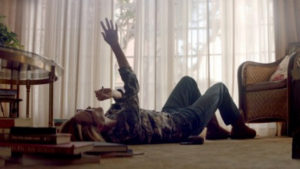 (Arnold owns and operates a business), and sex.
(Arnold owns and operates a business), and sex.
By this time in Gloria’s life, she has pretty much accepted being alone. But it is OK being with a guy right now. No strings. No future plans. As the plot develops, we learn that is definitely not Arnold’s mindset. Whereas Gloria is an independent soul, her new boyfriend is anything but. That is putting it, as they say, mildly.
Witness the time Gloria invites Arnold to meet her two kids, as well as her ex, Dustin, and his new wife. (Brad Garrett plays Dustin.) There are issues, thanks to Arnold. Or a trip to Vegas. Dreadful issues, thanks to Arnold. Without getting specific, Gloria could well have developed into a horror movie due to Arnold’s  obsessive behaviors and stalking tendencies.
obsessive behaviors and stalking tendencies.
But fear not such fears. Gloria has nothing to do with crimes of violence, but everything to do with crimes of the heart. Like Gloria herself, that latter is something we all fear.
Julianne Moore’s extraordinary performance convinces us that Gloria will not only survive, but conquer.
=====
GRADE, On A to F Scale: A-
‘Us,’ Jordan Peele’s nightmarish follow-up to ‘Get Out,’ features new horrors, old fears
 By Steve Crum
By Steve Crum
Since 2015, when he split from Kegan-Michael Key after years on TV as the hilarious Key & Peele, Jordan Peele’s showbiz life has gone onward and upward. He has kept his comedic roots alive by producing a couple of funny TV series—sans his onscreen presence. 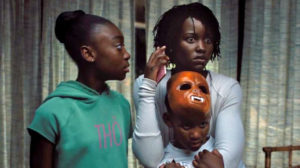
So it was surprising when he decided to make a foray into horror movies by way of producing, writing and directing. His first, 2017’s Get Out, was a critical and box office sensation. Peele deservedly won the Best Screenwriting Oscar, and the film was nominated for Best Picture and Best Directing.
Does he equal or top Get Out with this newest screamfest, Us? Well, not quite on both counts. But Us is still jammed with creepy shivers and high production values. It is a gotta-see for horror fans. You know a movie is really scary when audience members at the preview keep yelling at the screen, “Don’t open that door!” and “Look out!” (I didn’t say such, but I sure thought it.) Us contains abundant surprises, turns, and twists throughout.
Much like Peele’s Get Out, Us involves a seemingly innocent trip to a secluded home. [Incidentally, Us is NOT a sequel.] In this case, it is a family of four trekking to their summer home, which happens to be near the Santa Cruz, California beach. The couple, Gabe and Adelaide Wilson (Winston Duke and Lupita Nyong’o), have a teenaged daughter, Zora (Shahadi Wright Joseph), and younger son, Jason (Evan Alex).
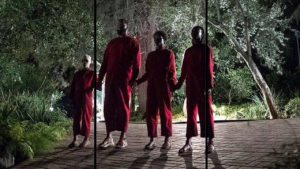 The couple moves in, and all goes well for a few hours, until Adelaide feels unstable and fearful, based solely on her instincts. At sundown, her fears are justified when four strangers dressed in red jumpers show up, standing in the driveway. So begins the Wilsons’ nightmare, playing out in murderous blood and screams for remainder of the film’s 116 minutes.
The couple moves in, and all goes well for a few hours, until Adelaide feels unstable and fearful, based solely on her instincts. At sundown, her fears are justified when four strangers dressed in red jumpers show up, standing in the driveway. So begins the Wilsons’ nightmare, playing out in murderous blood and screams for remainder of the film’s 116 minutes. 
A bit of a spoiler hint: The driveway four (known later as “The Tethered”) are also portrayed by the principal cast of Duke, Nyong’o, Wright Joseph, and Alex.
As the Wilsons are finally able to flee, there is a horrific encounter with their neighbors from down the street, Josh and Kitty Tyler (Tim Heidecker and Elisabeth Moss), and their two teen daughters. Incidentally, scissors and knives are integral to the action in Us. There is also a motorboat. And many more red jumpsuits.
Enhancing the film is a terrific music score by Michael Abels, who also scored Get Out. Kudos to cinematographer Mike Gioulakis as well.
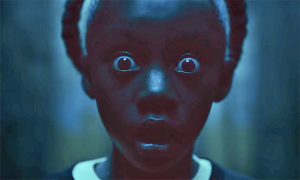 Overall, Us becomes a horror hybrid, infusing zombies + Invasion of the Body Snatchers + slasher flick touches + psychological chills. The movie’s first third is as terrifying and involving as a scary movie could be. The second third expands the plot with new characters and repeated terrors. By the finale, we are wondering where the movie has taken us. The conclusion seems hurried and muddled. That lack of resolution is the film’s weakness.
Overall, Us becomes a horror hybrid, infusing zombies + Invasion of the Body Snatchers + slasher flick touches + psychological chills. The movie’s first third is as terrifying and involving as a scary movie could be. The second third expands the plot with new characters and repeated terrors. By the finale, we are wondering where the movie has taken us. The conclusion seems hurried and muddled. That lack of resolution is the film’s weakness.
However, this does not detract from the thrill ride that is Us, and its stellar ensemble cast that has to perform in virtually every scene—often in duplicate roles.
=====
GRADE, Based upon A to F Scale: B+
‘Captain Marvel’ flies and zaps, managing some fun sequences within muddled plot

 By Steve Crum
By Steve Crum
Don’t you love it in 1941’s great black and white Republic Pictures serial, The Adventures of Captain Marvel, when young Billy Batson says “Shazam!” and—in a cloud of smoke—changes into the tall, muscular Captain Marvel (Tom Tyler), complete with short cape and bulging biceps?! That was then. NOW is female actress Brie Larson in Captain Marvel, via wide screen color, minus the cape. In fact, her entire costume is day and night opposite the comparatively drab ’41 wardrobe. So is her persona, including her powers in obliterating the bad guys.
Of the two versions, the original remains the classic. This 2019 take has flashier visuals, but so-so 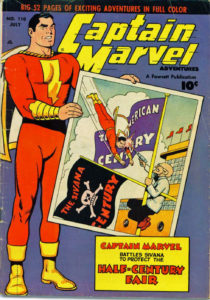 results. Comparing the two Captains encompasses 79 years of a hodgepodge of Captain Marvel makeovers in comic books, TV shows, and movies. Capsulizing Captain Marvel’s history, since Fawcett comic books created the character in 1939, is a daunting task. Bear with me.
results. Comparing the two Captains encompasses 79 years of a hodgepodge of Captain Marvel makeovers in comic books, TV shows, and movies. Capsulizing Captain Marvel’s history, since Fawcett comic books created the character in 1939, is a daunting task. Bear with me.
The metamorphosis from Billy Batson/Captain Marvel to Carol Danvers/Captain Marvel covers a long list of legal suits, copyright intrusions, and Hollywood one-upmanship. Fawcett comics first had Captain Marvel, but DC Comics sued and won, claiming Superman had essentially been ripped off. In the late 1960s, Marvel Comics legally resuscitated the Captain Marvel trademark. Then the superhero underwent no less than seven incarnations, from the alien military officer Captain Mar-Vell, in 1967, to monikers like Monica Rambeau, Genis-Vell, Phyla-Well, Khn’nr, Noh-Varr, and finally…Carol Danvers. (And don’t even confuse this Danvers with DC’s Supergirl and her secret identity, Linda Danvers. We are talking the Marvel Universe here.)
Cut to Larson’s Danvers in Captain Marvel, opening in theaters today, as she explores her meaning and purpose in life by way of codirectors Anna Boden and Ryhan Bleck—who also helped with the screenplay. This is Captain Marvel’s origin story, a sub-genre fans have come to expect thanks to the explosion of superhero movies during the last three decades. As such, Captain Marvel is the first Marvel-based superhero film to feature a woman as the single lead. 1984’s Supergirl holds that distinction for the DC Universe movies.

In a synopsis nutshell, Carol Danvers is having nightmares due to her past as a U. S. Air Force fighter pilot and member of a secret unit called Kree. An accident has imbued her with superhuman strength, energy protection, and the ability to fly like Iron Man—but without need for any special suit. One of the problems with Captain Marvel is just that: the redundant flying sequences are staged more impressively in the Iron Man series.
 At this point in the comic book movie genre, comparisons are unavoidable.
At this point in the comic book movie genre, comparisons are unavoidable.
The fun of Captain Marvel is not so much Danvers/Marvel, but her pal Nick Fury, portrayed by the ubiquitous Samuel L. Jackson. He is encountered in a trip back in time to 1995, before he became the Director of S.H.I.E.L.D. He’s just an agent now, along with his sidekick, Phil Coulson (Clark Gregg). Danvers is chasing bad guy shape-shifter Talos (Ben Mendelsohn), through a strip mall. (Blockbuster Video and Radio Shack stores are part of the nostalgic landscape.) Fury and his unit arrive on the scene after reports of violence. It is not long before Danvers dazzles Fury with her superpowers. When she and Fury eventually team, the movie sparks alive.
 As if the plot isn’t convoluted enough, there are additional characters Maria Rambeau (Lashana Lynch)—an old friend and fellow pilot; and Annette Bening as the Supreme Intelligence/Mar-Vell/Dr. Wendy Lawson. She is the collective intelligence of the greatest minds of the Krees, and ruler of their empire. Factor in Danvers’ mentor, Yon-Rogg (Jude Law), a good-bad guy that just might confuse you like he did me. In fact, most of Captain Marvel befuddled this casual fan of the Marvel Universe.
As if the plot isn’t convoluted enough, there are additional characters Maria Rambeau (Lashana Lynch)—an old friend and fellow pilot; and Annette Bening as the Supreme Intelligence/Mar-Vell/Dr. Wendy Lawson. She is the collective intelligence of the greatest minds of the Krees, and ruler of their empire. Factor in Danvers’ mentor, Yon-Rogg (Jude Law), a good-bad guy that just might confuse you like he did me. In fact, most of Captain Marvel befuddled this casual fan of the Marvel Universe.
But I did love the inclusion of the the stray cat, Goose, adopted by Nick Fury. Cuteness aside, beware his puddy tat mouth and claws. Enough said.
Captain Marvel seems more apt to shine among a group like the Avengers, a point suggested at the conclusion of the end credits. Remain seated if that interests you.
=====
 CAPTAIN MARVEL BITS:
CAPTAIN MARVEL BITS:
•Both Samuel L. Jackson and Clark Gregg appear 20+ years younger, believably so. The amazing transformation was done frame-by-frame, using computer digitalizing, great makeup, and wigs.
•Do not confuse Captain Marvel with the 1970s kid show, Shazam! THAT one was based upon the original Fawcett Captain Marvel. Just to make things more bananas, the DC version of Shazam! will be released next month.
=====
GRADE, Based upon A to F Scale: C+
